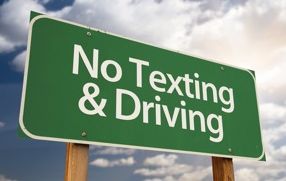 April is Distracted Driving Awareness Month, entering its fifth year. It’s an event without an official sponsor, but the NHTSA seems to be taking the lead with its “U Drive. U Text. U Pay.” campaign.
April is Distracted Driving Awareness Month, entering its fifth year. It’s an event without an official sponsor, but the NHTSA seems to be taking the lead with its “U Drive. U Text. U Pay.” campaign.
Meanwhile, law agencies are taking the opportunity to crack down on distracted drivers. Hawaii, California and Connecticut are among the states warning motorists of distracted driving sweeps in April, backed in large part by federal funds.
The National Safety Council once again took the occasion to promote the idea that hands-free use of electronic communications devices was no safer than handheld use. “More than 30 studies show hands-free devices are no safer because the brain remains distracted by the conversation,” the NSC said in its Distracted Driving Awareness Month message. The slogan is “Calls Kill: Hands-Free Is Not Risk Free.”
The NSC released the deceptively serene distracted driving video featuring a mom chatting hands-free with her husband. A child rides in a car seat. The chatting mom then runs a stop sign. The result appears the same as last year’s jarring teen video: (text continues)
The National Highway Traffic Safety Administration’s U Drive. U Text. U Pay. effort is backed by a $5 million media budget, to be spent on ads April 6-15. The TV, radio and digital ads target adults 18-34 with a “slight skew” toward women. The digital push seeks to “create a conversation around the danger of texting while driving” employing YouTube stars, BuzzFeed and Twitter as well as digital video.
In Hawaii, state officials and sponsors kicked off the awareness-month campaign April 1 at the State Capitol. The state unveiled its first distracted driving simulator. State DOT director Ford Fuchigami said: “Too many people think it’s okay to text, talk on the phone, or play with their mobile devices while driving, but doing so may lead to real consequences and unnecessary tragedies.”
In California, “high visibility enforcement days” are set for April 1 and 15, for the more than 200 enforcement agencies participating. The push coincides with California Teen Safe Driving Week, April 1-7.T The Office of Traffic Safety is encouraging drivers to “Silence the Distraction” in new public service announcements.
In New York, officers are running running a distracted driving sweep April 10-15, using unmarked vehicles. “State troopers will not hesitate to give tickets to drivers” who ignore the law, Police Superintendent Joseph D’Amico said.
In Connecticut, about 50 law-enforcement agencies are cracking down on distracted drivers throughout the month.
In New Jersey, a state that boasts what could be the nation’s toughest distracted driving laws, about 40 law agencies each received $5,000 federal grants for enforcement in April. Acting Attorney General John Hoffman said the state “must be as aggressive with distracted drivers as we have been with drunk drivers and people who refused to wear seat belts.”
In the state of Washington, more than 100 law agencies are participating during April.
Arkansas and New Mexico were among the other states running safety sweeps in April.
The U.S. Depart of Transportation, once home of the war on distracted driving, had little to say about the awareness month. The DOT’s Fast Lane blog — the bully pulpit for former DOT chief Ray LaHood — made no mention of the event, perhaps content to let the NHTSA carry the ball. U.S. Transportation Secretary Anthony Foxx kicked off the “U Text” campaign last year with a blog post.
Former U.S. Rep. Betsy Markey of Colorado made the Distracted Driving Awareness Month designation official in 2010, with the help of the victims and survivors group FocusDriven. The first Distracted Driving Awareness Month was in 2011. Markey has since left Congress.
The original congressional resolution encouraged “all people in the United States to consider the lives of others on the road and avoid distracted driving.” Markey’s resolution invoked the name of 9-year-old Erica Forney of Fort Collins, Colo., who was struck and killed by a distracted driver in 2008.
Read the distracted driving FAQ.


In spite of all the research and accumulated knowledge, states continue to encourage distracted driving by lulling uninformed drivers into believing that hands-free is safer than hand-held, which it is not. If they only realized that it’s all about money and not safety, maybe drivers would come to their senses..